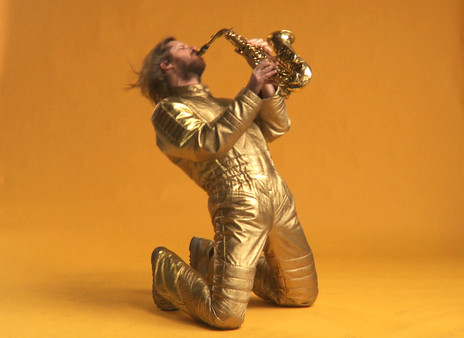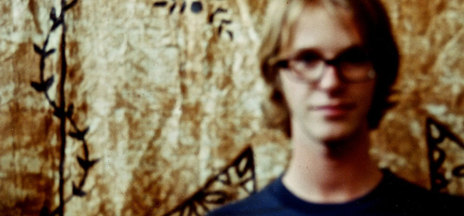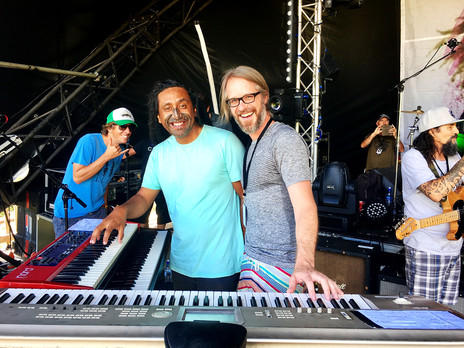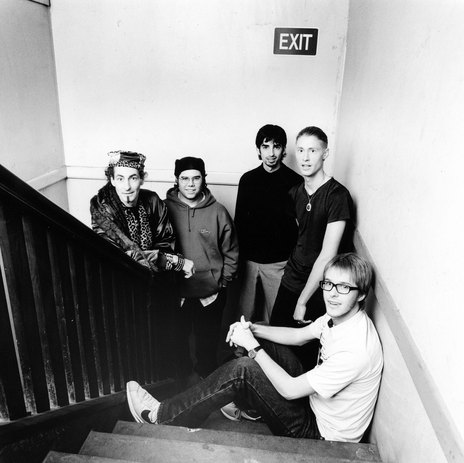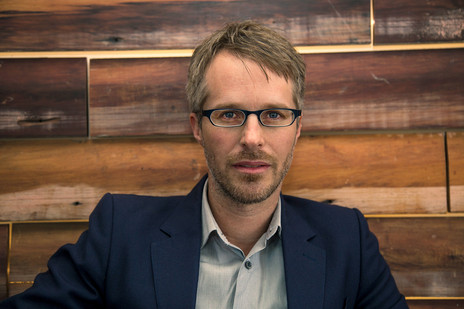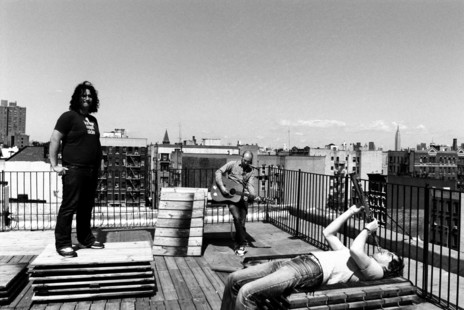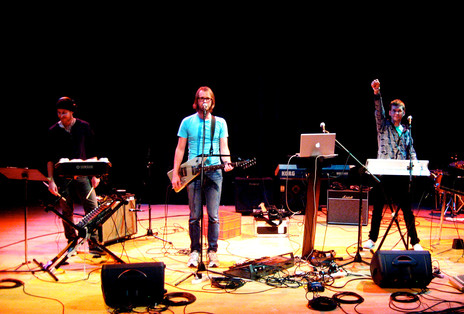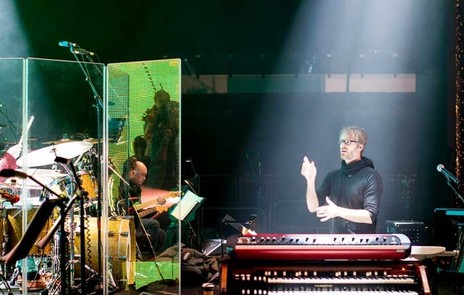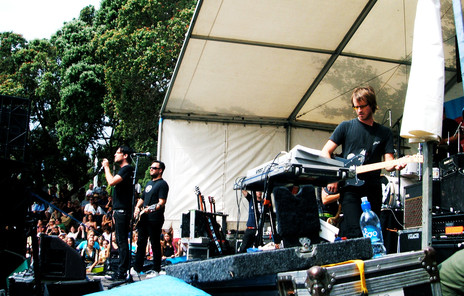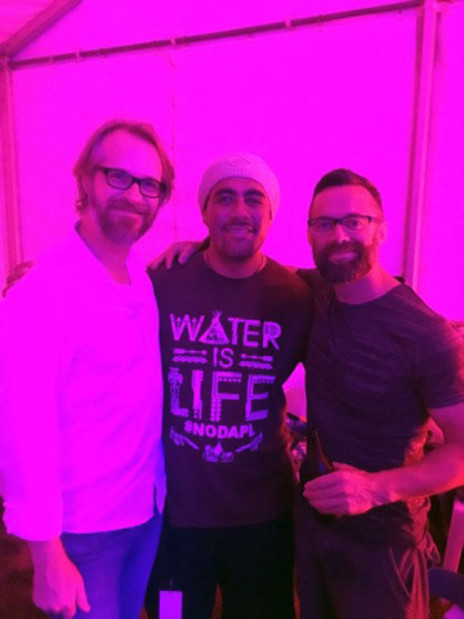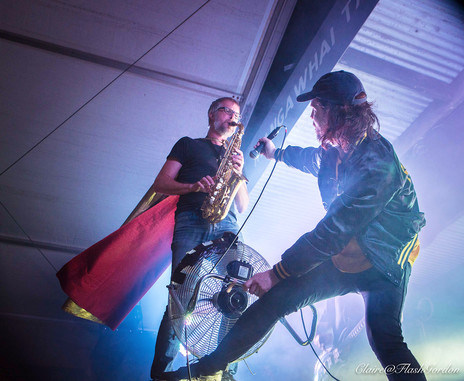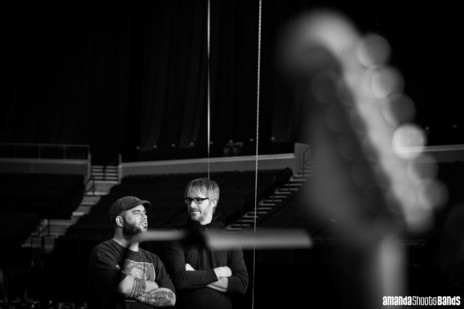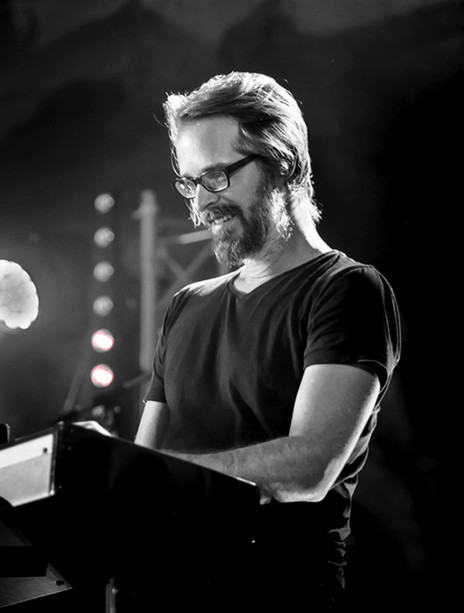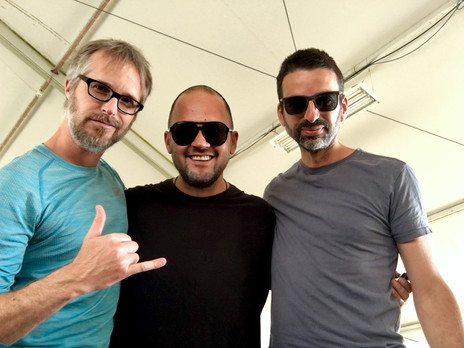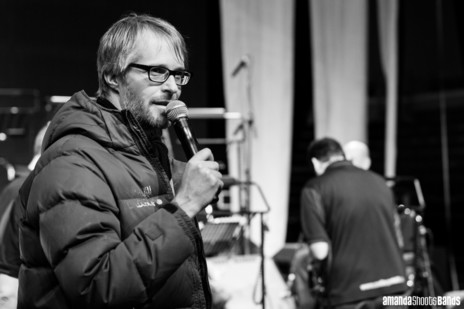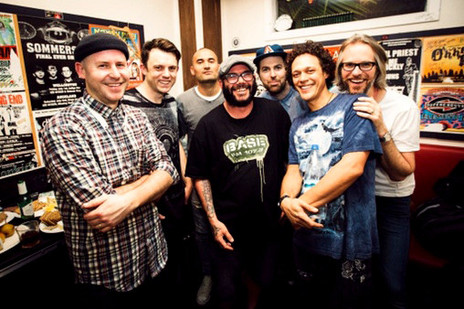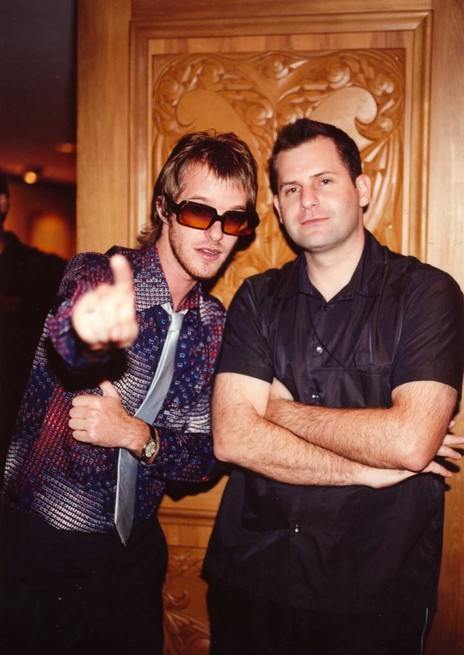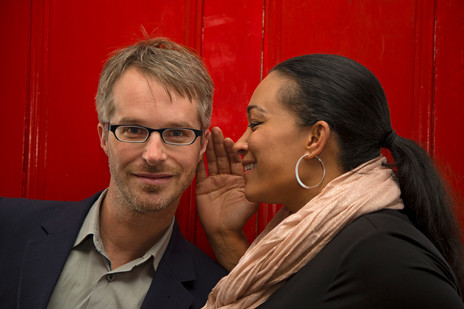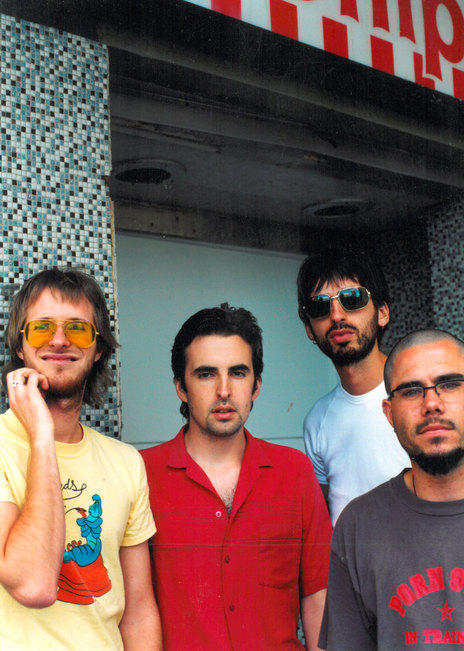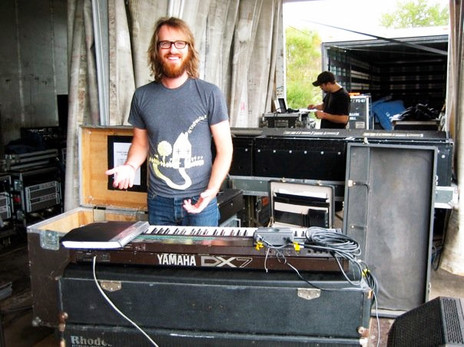In the 1990s, Auckland’s Northcote College gained a reputation for producing outstanding jazz performers. De Grut’s father taught at the school while Godfrey was still at intermediate but he brought him along to see two phenomenal young musicians from the school, Joel and Nathan Haines. It was enough to convince Godfrey that he had to attend the same school. Around the same time, the school hired inspirational music teacher Deece Guisinger, who was head of the music department for 28 years.
De Grut joined The Northcote College Jazz Band as a saxophonist and had beginner piano lessons. He was with the group when they won top prize at the Tauranga National Jazz Festival in 1994. This also put him within a run of great musicians that came through the school in the 90s which includes Nashville-based session bassist/vocalist Vanessa McGowan and saxophonist Cam Allen (Opensouls, Circling Sun), Hollie Smith is another noted former student.
Jazz years
De Grut went on to study composition at the University of Auckland, though the only option available at that time was a degree in classical composition. However, he followed Haines in embracing the new style of acid jazz that had gained popularity in the nightclub scene, with laidback horn grooves riding over funky beats and electronic backing.
In 1996, he joined with guitarist Dan Sperber and drummer Isaac Tucker to form The New Loungehead, updating the sound of the original Loungehead band that started a year earlier. The line-up was completed by bassist Glenn “Chip” Matthews, and percussionist Matthias Sudholter. The New Loungehead’s debut album Came A Weird Way (1997) won Best Jazz Album in 1998. De Grut also recorded an album with saxophonist Chris White in his band Buckle. By the following year The New Loungehead had split and Sperber formed Relaxomatic Project with Luke Casey, but they brought De Grut in to record and perform.
AT 14, DE GRUT SAW THE RODGER FOX BIG BAND, AND DREAMED OF JOINING THE GROUP
Central Auckland was a buzzing scene at the time. “High Street was such a hub,” he says, “you could really do a lot of performances. Me and Chip once did three gigs in one night – we did Deschlers, Rakinos, and Cause Celebre. The full trifecta!”
During this period, De Grut received a phone call that would lead to one of his busiest periods on the live circuit. When he was 14 he saw The Rodger Fox Big Band perform at the Auckland Town Hall with Arturo Sandoval and was so blown away that he dreamed of one day joining the group. Seven years later Rodger offered him a place in his ensemble.
De Grut spent 12 years playing saxophone with The Rodger Fox Big Band, gaining a wealth of experience, whether touring through the US and Australia or playing alongside jazz legends such as Michael Brecker, Dave Weckl and Steve Smith. He had a chance to write for the group, his track ‘Prince Lucy’ appearing on their album Xtra Juicy (1998).
From hip hop to pop
During his time at university, De Grut often found it easiest to communicate his composition ideas to a band using a piano/keyboard. He began to play more keys in The New Loungehead as time went on, since it allowed him to control a wide variety of sounds and textures.
Meanwhile, De Grut’s old bandmates Chip Matthews and Isaac Tucker had been playing with hip hop performer Che Fu. Matthews suggested De Grut audition for the band primarily as a keyboard player, and he joined just as they were writing music for Che Fu’s second album, Navigator (2000). Che might not have had experience in formal composition, but he knew the sound he was after and pushed his band to get the right feel.
‘Misty Frequencies’ is a great example of what De Grut brought to the table. The opening chords have a hint of jazz to them, but still sound like the type of funky Rhodes piano part that Stevie Wonder might have played. He had originally written it for one of the jazz outfits that he and Matthews played in, but he thought Che might like to use it as walk-on music. Instead, Che added a sublime vocal melody. The song became a Top 10 hit, leading to Che Fu and De Grut winning the 2002 APRA Silver Scroll.
De Grut’s studio work began to snowball with contributions to a gold-selling album by pop singer K’Lee and a multi-platinum album by hip hop act Nesian Mystik. He was also contacted by Elemeno P – he met Dave Gibson and Justyn Pilbrow through playing at the same events in their respective high school big bands and the trio had gone on to do nightclub jazz gigs together. This led to De Grut working on yet another multi-platinum album, Elemeno P’s Love & Disrespect (2003). Gibson and Pilbrow also asked him to create a jazz version of their song ‘Nirvana’ as a B-side, and he brought in the Rodger Fox Big Band to record it.
De Grut also played on over half the tracks on Brooke Fraser’s massive-selling album What To Do With Daylight (2003), which gave him his first chance to compose string parts (for ‘Arithmetic’ and ‘Mystery’).
De Grut branched out to start a rock band: Menopanteboy
De Grut branched out to start a rock band, Menopanteboy, with Karena Lyons, Neil Watson, Nick Gaffaney, and Chip Matthews. His uncle had always encouraged him to play guitar as well and he gradually grew in confidence over the years, until it became another string to his bow when working as a session player for live gigs. Menopanteboy gained NZ On Air funding to record a song and filmed a music video but were told by an NZ On Air rep that it wouldn’t be promoted because it was “too silly”.
De Grut took a step back closer to the jazz of his youth when Chip Matthews brought him in to play with two other musicians he’d been jamming with, Jeremy Toy and Julien Dyne, which saw De Grut becoming an occasional member of Opensouls. De Grut also had a chance to work with the other breakout stars from his old school, Nathan Haines and Hollie Smith.
Working as a studio musician and live performer meant De Grut seldom settled into one genre for long. He moved from the pop of Carly Binding to the chart-topping rap of Scribe to the tongue-in-cheek rock of Deja Voodoo, and anything in between.
The most shocking was a surprise call to take part in a session with Kanye West.
Kanye West was in Australasia because he had been booked to support U2. The shows were postponed, so instead he booked time at Neil Finn’s Roundhead Studios. De Grut was contacted by sound engineer and producer Neil Baldock to see if he was willing to be involved. This led to De Grut jamming chords along to a dozens of beats that West was developing for the rapper Common, while a backing vocalist ad-libbed over the top. West vibed with the sounds that they were getting at first and they fell into a gospel-infused feel. The rapper wasn’t shy of cutting things off if he wasn’t happy, telling De Grut at one point, “Don’t ever play that chord again!”
Neil Finn popped his head in and offered to play one part, the rapper Common was on hand to trade verses with West, and phone calls came in from Nas and Jay-Z. It was a heady environment for De Grut but he managed to keep up and was invited back for a second day, though his handiwork didn’t appear on any subsequent releases.
New challenges
For over a decade, De Grut moved between the studio and the live stage, but he was eventually drawn to different roles that would test his skills in new ways.
In 2008, De Grut took a job as a lecturer in popular music at the University of Auckland. He got married around this time to singer Cherie Mathieson. This led to a gradual change in the music work he undertook.
In 2008, De Grut became a lecturer in popular music at the University of Auckland
“Starting a family meant I was doing fewer one-off gigs, he says, “it was harder mentally to just jump on stage without proper rehearsals unless you’re doing it a lot. I was still touring, and I was lucky to have a few artists that I continued to work with over the years. Then slowly but surely more university work crept into my life, and it meant I couldn’t tour as easily. It soon got to the point where my wife was doing more gigs than I was.”
In 2009, De Grut had his first experience as an album producer, working alongside Andrew Buckton with the band Dukes on Still Life (2010) which spawned the platinum single ‘Vampires’.
He was hired to be the musical director for the 2013 APRA Silver Scroll Awards, choosing artists to cover the finalists’ songs and helping them with the arrangements. One of the most striking moments was when Aaradhna’s ‘Wake Up’ was performed by an ensemble that included three talented drummers, De Grut’s old bandmate Nick Gaffaney, Elemeno P’s Scotty Pearson, and Katie Everingham from The Beths.
He had in-depth discussions about how to approach the Silver Scrolls performance with his wife and the pair began working together more formally. De Grut and Mathieson were artistic directors for the 20th anniversary of Christmas in the Park in 2014 and reprised the role the following year. They also returned as musical directors for the APRA Silver Scrolls 50th Anniversary performances in 2015.
De Grut was still drawn to working with newer acts that he admired, including Maisey Rika, Tama Waipara, Anika Moa, and Seth Haapu. He’s also taken the opportunity to play with musicians he admires such as Boh Runga.
“Stellar* really showed that a local act could break through as a full band rather than a solo act like Bic [Runga]. One of the bands I’ve really enjoyed working with over the years is Boh Runga, because I always wanted to play in Stellar*! I got really close because Andrew [Mclaren] and Boh did a gig together and I played in their band. Then Kurt and Boh did a gig together and I played in their band, but I’ve never been on stage with everybody. One day!”
Between 2007 and 2017, De Grut wrote the X-factor column for NZ Musician magazine, in which he broke down the underpinnings of popular songs, often uncovering key changes, interesting chord-melody combinations, or switches in musical modes that the songwriters themselves may not have even been aware of.
One side benefit of his job at the university is newer musicians coming through, including Amelia Murray (Fazerdaze), Ash Wallace (Foley), and Phoebe Jasper (Navvy, and songwriter for the likes of Rita Ora). There are some who have taken up his beloved style of jazz – on one occasion, he heard an interesting mix coming from one of the practice rooms and poked his head in to find Yoko-Zuna playing wild horn riffs over heavy electronic beats. More recently, he managed to get the group’s award-winning guitarist Kenji Iwamitsu-Holdaway to teach at the university and enjoys seeing how jazz influences are being folded into modern music by the students.
Through his work, De Grut continues to provide an invaluable contribution to the New Zealand music scene, both as an educator and musician. His passion for music, expertise, and versatility have made him one of the most respected figures in the industry.
